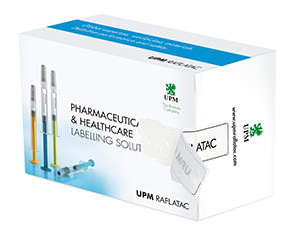UPM Raflatac has developed a range of pharmaceutical labelling products to support compliance with the Falsified Medicines Directive on packaging for prescription drugs and high-risk, over-the-counter medicines. Few solutions offer the same ease of adoption for meeting the February 2019 deadline.

The Falsified Medicines Directive (2011/62/EU) places two demands on pharmaceutical product packaging. Packs should carry a unique serial number to identify and authenticate individual products, and they should be sealed in a way that visibly enables tamper-verification.
Details on how the authenticity of medicines should be verified and by whom, as well as the characteristics of the safety features, were finalized and published this February under Commission Delegated Regulation (EU) 2016/161. This supplements core Directive 2001/83/EC on the Community code relating to medicinal products for human use and regarding the prevention of falsified medicinal products entering the legal supply chain.
An estimated 30 billion medicinal packs are sold and handled annually in Europe. The deadline for pharmaceutical packaging compliance with the Falsified Medicines Directive is 9 February 2019 in the majority of EU member states.
Solutions focused on surety of compliance
While the delegated regulation (EU) No 2016/161 stipulates that an anti-tampering device has to enable verification of package tampering, there is no elaboration on mandatory specifications. However, the European Commission Directorate-General for Health and Food Safety advises that guidance can be taken from the new CEN standard EN 16679:2014 “Tamper verification features for medicinal product packaging”.
This CEN standard is the route UPM Raflatac pursued in the development of tamper-evident labelling products meeting an urgent market need for solutions compliant to the Falsified Medicines Directive. The result is a range of package sealing materials based on the RP62 EU adhesive. RP62 EU creates visible cardboard tear when attempts are made to remove labels from typical pharmaceutical drug cartons. The labels cannot be smoothed back down.
RP62 EU is available with a range of clear film as well as paper-based label faces, and an RP62 EUL variant enables missing label detection by luminescent detector. Pharmaclear PP Seal visibly stretches on removal, and Pharmaclear PP Tear TC displays the surface torn from tampered packs. The ultra-destructible Acrylate Gloss Clear UD label film is irreversibly torn or broken when sealing labels are tampered with. The Tamperproof paper face either breaks or delaminates, and the conformable and fragile Pharmatight paper reveals damage or fractures. More new products are to follow.
Easy adoption with existing pack designs
As per the Falsified Medicines Directive, drug package serial numbers and integrity are verified at the point of dispensing, where medicines are released to consumers and patients. The serial numbers are checked against the drug manufacturer’s database, and the package integrity by visual inspection.
“UPM Raflatac actively engages with the pharma industry and anticipates legislative change, focusing our materials development precisely for market needs. For many pharmaceutical product lines, our PSA label solution is the preferred option. It comes down to the combination of effective tamper-verification and simplicity of implementation,” explains Markku Pietarinen Labelling Solutions Manager for Pharma at UPM Raflatac EMEIA.
Options to combine the RP62 EU adhesive with clear label films adds to the ease of adoption – they blend seamlessly with existing carton designs.
“As a concept it’s quite straightforward,” Pietarinen says. “There’s no simpler way for Pharmaceutical manufacturers to achieve the tamper-evidence required by the Falsified Medicines Directive, and continue with existing package layouts and packaging stocks.”
Tamper-verification with the RP62 EU adhesive
UPM Raflatac tamper-evident products with the RP62 EU adhesive exploit the properties of the cardboard typically used for pharmaceutical packaging, which carries a water-based varnish. The adhesive works by facilitating cardboard tear between the bleached chemical pulp and BCTMP layers in the cardboard construction.
Lifting or removing the label rips away the surface of the cardboard, causing highly visible and irreversible damage as an indication of package tampering.
Combining the tamper-verification functionality of the RP62 EU adhesive with a clear, filmic label face doesn’t cover the information printed on the box: When fulfilling the requirements of Directive 2011/62/EU, there’s no need to change the graphic design of existing packages.
Read more:
UPM Raflatac's labeling solutions for tamper-evident, anti-counterfeiting and patient safety
Pharmaclear PP Seal RP 62 EU introduces doubly effective counterfeit protection for pharmaceuticals